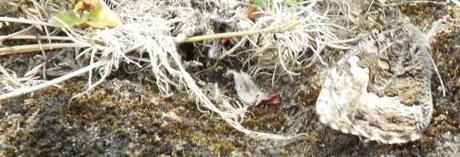
Last weekend I went to visit Bissoe Downs, a little west of Truro, with a group of like-minded people from Cornwall Butterfly Conservation in search of Graylings (the butterflies, not the fish…).
Leaving your vehicle in a small car park (SW 783408), there are various well-made paths you can take. Dodging cyclists and joggers and enjoying the warmth of the day, we headed towards the nine arches of the Carnon Viaduct, which carries the Falmouth−Truro trains, opened in 1933 to replace an earlier mixed masonry and timber construction designed by Brunel. Take a look at the picture at the top of this post: the topless masonry piers below the arches are the remains of the previous viaduct, which once supported a timber frame along which the trains ran, and which are referred to as ‘Brunel’s stumps’ – there are several across Cornwall.
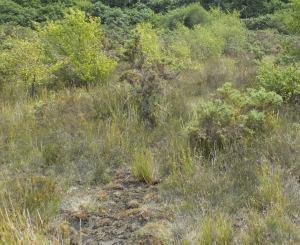
Bissoe Downs (photo: Amanda Scott)
The area around the paths is in fact a previous arsenic mining site. Just up the road, Bissoe Valley Nature Reserve, owned and managed by the Cornwall Wildlife Trust, is an excellent example of how these previously mined sites can be restored, providing a haven for wildlife and recreation for us humans. Here, on Bissoe Downs, to either side of the path the land is naturally regenerating, with a succession of heathland scrub and trees such as birch.
Contaminated old metalliferous mining sites can, perhaps surprisingly, be more ecologically rich than you might think. This short report from Cornish Mining World Heritage makes interesting reading. These sites can even provide homes for species that are otherwise nationally rare but are tolerant of heavy metals, such as Cornish Path Moss (Ditrichum cornubicum), now found in only two copper-contaminated locations in Cornwall.
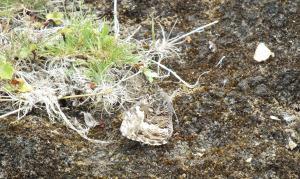
Can you spot the Grayling? (Photo: Amanda Scott)
Here at Bissoe, the case in point is that of the Grayling (Hipparchia semele), a butterfly that likes to bask on patches of rocks or dry bare earth, of which there are plenty of the latter on the thin soils of this site. The colouring of the undersides of its wings, which it holds closed when at rest, with hind wings covering the forewings, also camouflages it well in this habitat. You’ll spot it quite quickly in the photograph to the left, but imagine trying to find it in the middle of an entire heathland!
Here it is a bit closer…
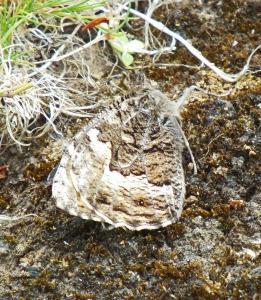
Grayling (photo: Amanda Scott)
This photograph was taken almost directly from above the butterfly, so notice how it has tilted its wings at an angle away from the vertical. The sun was behind me and to the right – perfect for the photograph, and perfect for the Grayling which has exposed as much surface area of its wing as possible to the sunlight. Not only is this good for basking but it also means that this cryptic butterfly casts hardly any shadow – excellent for camouflage. It is not often one gets to see the more orange coloured upper side of its wings.
Graylings have in fact only recently been discovered at this site (by Phillip Harris, a committee member and previous Chairman of Cornwall Butterfly Conservation, as well as all-round expert naturalist). Graylings are now most often found on coastal sites in Cornwall, with only a small handful of inland locations to their name, so this site was an exciting find.
There was a time when Graylings would have been much more widely distributed. I’ve mentioned before on this blog my butterfly book from 1968. There it says that the Grayling is “widely distributed all over the British Isles, usually in dry, exposed places. Colonies may be found on steep granite cliffs above the sea, on rough moorland and commons, stony hillsides and chalk downs” (Mansell, E. and Newman, L.H., 1968. The Complete British Butterflies in Colour. Ebury Press, London).
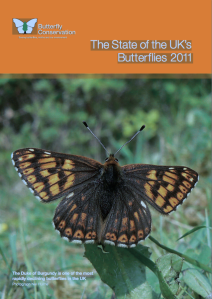
The Grayling is the largest of our ‘brown’ butterflies. It exhibits variation between populations across the country, with six subspecies in the UK. The main food plants of its caterpillars are grasses such as Bristle Bent, Red Fescue and Sheep’s Fescue, and the adults like to nectar on plants such as Bird’s-foot Trefoil, Heather and Red Clover. It is a priority species under the UK’s Biodiversity Action Plan.
The Grayling, and other butterflies, are of course not just important for their own sake (which they are) but because they are sensitive indicators of climate and habitat change. With annual broods and specific habitat requirements they are often amongst the first species to respond to changes in the environment. If we want to continue to enjoy the sight of butterflies in Cornwall and the wider UK, we all need to take note and support those, such as Butterfly Conservation and its local branch, and the RSPB’s Give Nature a Home campaign, as well as our own Cornwall Wildlife Trust, who are all working to preserve habitats and species.
Did we find Graylings at Bissoe? Actually, yes…well over 30! Which just goes to show there is always hope.
